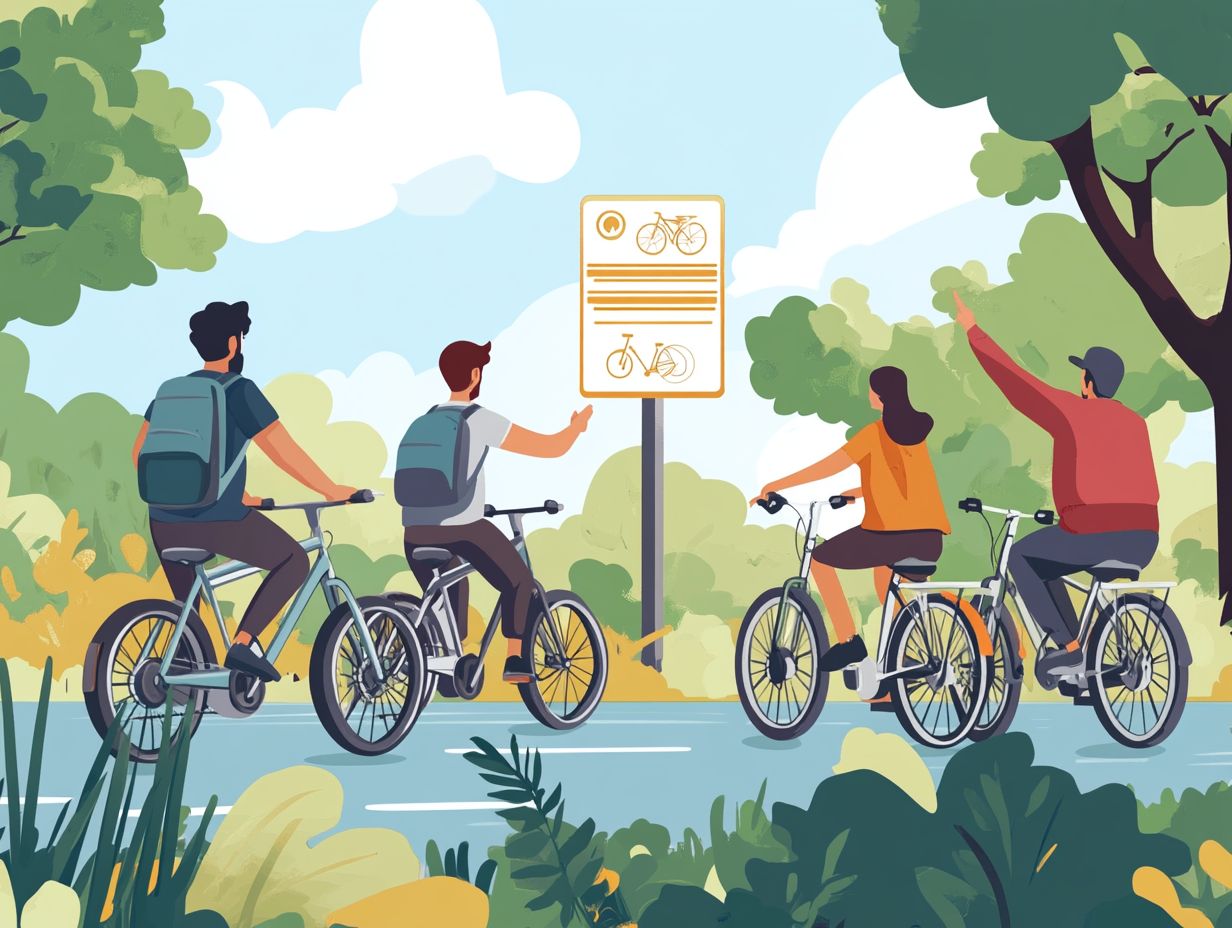What Every Electric Bicycle User Should Know About Laws
Electric bicycles are gaining traction, but navigating the legal landscape surrounding them can be quite the challenge.
From state-specific regulations to federal laws, grasping what s permissible is essential for every rider. This guide breaks down the key laws and regulations, provides invaluable safety tips, and clears up common myths that often leave users perplexed.
Whether you re a seasoned rider or just taking your first steps, this information will empower you with the knowledge necessary to ride safely and legally.
Contents
- Key Takeaways:
- State Laws and Regulations
- Federal Laws and Regulations
- Safety Tips for Electric Bicycle Riders
- Common Misconceptions About Electric Bicycle Laws
- Frequently Asked Questions
- What Every Electric Bicycle User Should Know About Laws, Including Consumer Product Safety Commission Guidelines?
- What is an electric bicycle?
- Do electric bicycles need to be registered?
- What speed can electric bicycles reach?
- Do I need a license to ride an electric bicycle?
- Are there any restrictions for riding electric bicycles?
- Can I ride an electric bicycle on the road?
Key Takeaways:

- Familiarize yourself with both state and federal laws to ensure you ride safely and legally.
- Safety is crucial for electric bicycle riders, so follow safety tips to protect yourself and others.
- Research and clarify misconceptions about electric bicycle laws to ensure compliance with regulations.
Understanding the Basics
Understanding the fundamentals of electric bikes, or e-bikes, is crucial if you re considering them as a transportation solution. Electric bicycles are classified into three types: Class 1, Class 2, and Class 3. Each type has unique features like pedal-assist, which helps you pedal, and throttle-assist.
E-bikes offer a compelling combination of eco-friendliness, convenience, and freedom, making them appealing for urban commuters and cycling enthusiasts alike. As their popularity rises, it’s essential to familiarize yourself with the key legal considerations for electric bicycle riders, which can vary dramatically from one state or locality to another.
One significant advantage of these bicycles is their ability to make cycling accessible to a wider audience, including those who might find traditional biking physically demanding. With a rechargeable battery that powers the motor, you can cover greater distances with less effort, promoting a healthier lifestyle. To ensure a safe and enjoyable ride, it’s important to be aware of electric bicycle path regulations.
As cities worldwide embrace sustainability, e-bikes are recognized as a vital solution to reduce traffic congestion and lower carbon emissions. Research shows that e-bikes not only encourage more individuals to cycle but also provide substantial economic benefits by cutting transportation costs, underscoring their viability as a modern mode of urban transit.
State Laws and Regulations
Navigating state laws and regulations about e-bikes can resemble a legal maze, with requirements differing considerably from one location to another. For example, California has e-bike laws that clearly define the classification and usage of electric bicycles on public roads and bike paths.
As a rider, it’s essential to grasp local regulations to ensure compliance with state-specific laws, including registration and licensing requirements. To stay informed, it’s important to understand electric bicycle laws in California. These factors significantly influence your road use and safety standards, making informed awareness a vital part of your riding experience.
Overview of State-Specific Rules
Every state has its own unique set of e-bike regulations, and it’s essential for you to be aware of them. These rules often classify electric bikes into three categories: Class 1, Class 2, and Class 3. Each classification dictates the level of assistance the bike provides, which shapes the laws governing their use on public roads. You’ll also find that age restrictions and helmet laws are crucial elements of these regulations, designed to enhance safety for every rider.
Typically, Class 1 e-bikes offer pedal-assist, which means help from the bike as you pedal, cutting off assistance once you hit 20 mph. Class 2 models, on the other hand, come with a throttle option, allowing you to zip along without pedaling, but they’re also capped at 20 mph. If you’re considering riding in natural areas, it’s important to familiarize yourself with electric bicycle use in national parks.
If you choose a Class 3 e-bike, be prepared for a thrilling ride; these machines assist you up to 28 mph. However, it’s important to understand the top 5 electric bicycle laws that come with stricter usage policies, especially in urban settings and bike lanes.
States often require younger riders to wear helmets to underscore the importance of safety. For instance, California has rolled out clear rules for e-bike use in parks and off-road trails, adding another layer to the intricate web of regulations that every rider must navigate. To better understand these rules, check out electric bicycle regulations: a global overview. Staying informed is key to your safety and enjoyment!
Important Considerations for Riders

For e-bike riders, grasping essential considerations like traffic laws and safety standards can significantly elevate your riding experience. Many common misunderstandings about e-bikes can lead to unsafe practices, increasing the likelihood of accidents and injuries. By staying informed about e-bike safety tips, you can navigate both urban and rural environments more safely, effectively reducing potential risks.
Critical factors include:
- Always wearing a helmet
- Using lights and reflective gear for visibility
- Being aware of the specific rules governing e-bike usage in your area
Misconceptions, such as assuming e-bikes can be ridden on all bike paths, can lead to fines or even dangerous situations. Familiarize yourself with the various classes of e-bikes, as these classifications dictate where you can legally ride. Prioritizing safety and knowledge can make a significant difference in preventing accidents and ensuring a smooth ride.
Federal Laws and Regulations
Federal laws and regulations, primarily overseen by the Consumer Product Safety Commission (CPSC), are crucial in shaping the legal landscape for electric bicycles throughout the United States. The CPSC has set forth guidelines that define safety standards and legal classifications of e-bikes, influencing how you can operate these vehicles in different areas.
Familiarizing yourself with these federal regulations is vital for ensuring compliance alongside any state-specific rules that may apply.
Implications for Electric Bicycle Users
The implications of federal laws and regulations for electric bicycle users are significant, as these rules directly impact your daily operations and safety practices. By understanding e-bike laws, you can navigate the complexities of compliance while promoting safe riding habits.
With a focus on safety standards, you ll gain a clearer appreciation of your rights and responsibilities under federal regulations. When you adhere to these legal frameworks, you not only protect yourself but also foster a more harmonious relationship with other road users.
Compliance reduces the likelihood of accidents and nurtures a culture of responsibility among e-bikers, leading to a safer riding environment for everyone. Staying informed about navigating electric bicycle licensing requirements also encourages you to invest in high-quality equipment, enhancing your overall riding experience. This proactive approach mitigates legal risks and enables you to advocate for your needs within the broader context of transportation policy.
Safety Tips for Electric Bicycle Riders
Safety tips for electric bicycle riders are essential to mitigate the risk of injuries. These tips address the concerning accident statistics that have caught the attention of cycling advocates and public health officials.
By adopting best practices, you enhance your own safety and foster a more favorable perception of e-bikes as legitimate transportation alternatives. To stay informed, consider the 5 essential questions about e-bike laws. Prioritizing safety allows you to enjoy the freedom and convenience these vehicles offer while significantly reducing potential risks.
Protecting Yourself and Others

Protecting yourself and others while riding an e-bike involves embracing helmet laws and safety standards that prioritize public health. E-bike safety tips emphasize the importance of wearing a helmet, obeying traffic laws, and staying alert to your surroundings. These practices create a safer riding environment for everyone.
By adopting these habits, you not only safeguard yourself but also pedestrians and other road users. Helmets should be a non-negotiable part of your ride, as they significantly reduce the risk of head injuries in the event of an accident. Staying aware of your surroundings like anticipating sudden stops or pedestrians unexpectedly stepping into the road can help you avoid collisions.
Engaging in cautious riding and frequently evaluating your environment is key. By following established safety regulations, such as maintaining proper speed limits and using bike lanes whenever possible, you contribute to community safety while enjoying the numerous benefits of e-biking. Additionally, understanding what to know about electric bicycle components can enhance your riding experience.
Common Misconceptions About Electric Bicycle Laws
Common misconceptions about electric bicycle laws can create confusion for riders. Many individuals may not fully understand the legal definition of e-bikes, which can lead to misunderstandings about usage, classification, and adherence to local regulations.
Let s clear up these myths to cultivate a safer and more informed cycling community.
Debunking Myths and Clarifying Facts
Debunking myths and clarifying facts about e-bike laws is crucial for you as an electric bicycle user navigating the often murky waters of regulations. Misconceptions can confuse you regarding legal compliance and safety responsibilities, putting you at risk for accidents or legal troubles. Clear and accurate information can enhance your riding experience and help you ride with confidence.
For example, many believe that all e-bikes require licensing or insurance, but regulations vary significantly by jurisdiction. Understanding electric bicycle safety regulations promotes safer riding while ensuring you’re adhering to local laws.
Myths about e-bike capabilities and limitations might also be holding you back from considering one. By clarifying the genuine benefits like how these bikes can revolutionize your commute and boost mobility we can encourage broader acceptance of e-bikes.
As electric bicycles gain popularity, being well-versed in the laws and technology is essential for ensuring a safe and enjoyable experience on the road.
Frequently Asked Questions
What Every Electric Bicycle User Should Know About Laws, Including Consumer Product Safety Commission Guidelines?

Electric bicycles are becoming increasingly popular as an alternative mode of transportation. However, it’s important for users to be aware of the laws surrounding their use. Here are some frequently asked questions about electric bicycle laws.
What is an electric bicycle?
An electric bicycle, also known as an e-bike, is a bicycle that has an electric motor and battery attached. The motor assists the rider, making it easier to pedal and reach higher speeds.
Stay informed about e-bike laws for your safety and enjoyment. Join community discussions about e-bike safety and help promote a safer riding environment for everyone!
Do electric bicycles need to be registered?
Most electric bicycles don’t need registration. Always check with your local government to be sure, as rules can differ.
What speed can electric bicycles reach?
Electric bicycles can go fast! Many reach speeds of up to 20 mph, depending on the motor’s size and power.
Do I need a license to ride an electric bicycle?
In most areas, you don t need a license to ride an electric bicycle. Be aware of any age limits and safety gear requirements.
Are there any restrictions for riding electric bicycles?
Some locations restrict where you can ride electric bicycles, such as on sidewalks or bike paths. Always confirm local rules before you ride.
Can I ride an electric bicycle on the road?
Yes! Electric bicycles are allowed on the road just like regular bicycles. Remember to follow traffic laws and watch out for other vehicles.





